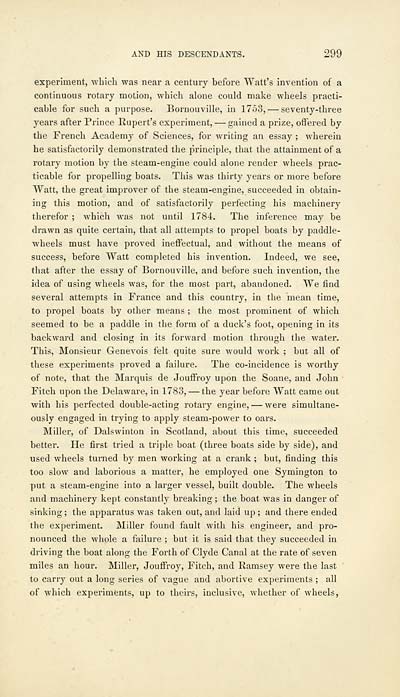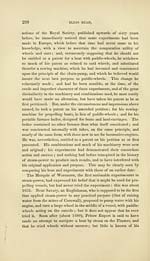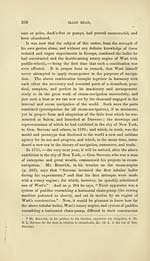History of the Reed family in Europe and America
(315) Page 299
Download files
Complete book:
Individual page:
Thumbnail gallery: Grid view | List view

AND HIS DESCENDANTS. 299
experiment, which was near a century before Watt's invention of a
continuous rotary motion, which alone could make wheels practi-
cable for such a purpose. Bornouville, in 1753, — seventy-three
years after Prince Rupert's experiment, — gained a prize, offered by
the French Academy of Sciences, for writing an essay ; wherein
he satisfactorily demonstrated the principle, that the attainment of a
rotary motion by the steam-engine could alone render wheels prac-
ticable for propelling boats. This was thirty years or more before
Watt, the great improver of the steam-engine, succeeded in obtain-
ing this motion, and of satisfactorily perfecting his machinery
therefor ; which was not until 1784. The inference may be
drawn as quite certain, that all attempts to propel boats by paddle-
wheels must have proved ineffectual, and without the means of
success, before Watt completed his invention. Indeed, we see,
that after the essay of Bornouville, and before such invention, the
idea of using wheels was, for the most part, abandoned. We find
several attempts in France and this country, in the mean time,
to propel boats by other means ; the most prominent of which
seemed to be a paddle in the form of a duck's foot, opening in its
backward and closing in its forward motion through the water.
This, Monsieur Genevois felt quite sure would w r ork ; but all of
these experiments proved a failure. The co-incidence is worthy
of note, that the Marquis de Jouffroy upon the Soane, and John
Fitch upon the Delaware, in 1783, — the year before Watt came out
with his perfected double-acting rotary engine, — were simultane-
ously engaged in trying to apply steam-power to oars.
Miller, of Dalswinton in Scotland, about this time, succeeded
better. He first tried a triple boat (three boats side by side), and
used wheels turned by men working at a crank ; but, finding this
too slow and laborious a matter, he employed one Symington to
put a steam-engine into a larger vessel, built double. The wheels
and machinery kept constantly breaking ; the boat was in danger of
sinking; the apparatus was taken out, and laid up; and there ended
the experiment. Miller found fault with his engineer, and pro-
nounced the whole a failure ; but it is said that they succeeded in
driving the boat along the Forth of Clyde Canal at the rate of seven
miles an hour. Miller, Jouffroy, Fitch, and Ramsey were the last
to carry out a long series of vague and abortive experiments ; all
of which experiments, up to theirs, inclusive, whether of wheels,
experiment, which was near a century before Watt's invention of a
continuous rotary motion, which alone could make wheels practi-
cable for such a purpose. Bornouville, in 1753, — seventy-three
years after Prince Rupert's experiment, — gained a prize, offered by
the French Academy of Sciences, for writing an essay ; wherein
he satisfactorily demonstrated the principle, that the attainment of a
rotary motion by the steam-engine could alone render wheels prac-
ticable for propelling boats. This was thirty years or more before
Watt, the great improver of the steam-engine, succeeded in obtain-
ing this motion, and of satisfactorily perfecting his machinery
therefor ; which was not until 1784. The inference may be
drawn as quite certain, that all attempts to propel boats by paddle-
wheels must have proved ineffectual, and without the means of
success, before Watt completed his invention. Indeed, we see,
that after the essay of Bornouville, and before such invention, the
idea of using wheels was, for the most part, abandoned. We find
several attempts in France and this country, in the mean time,
to propel boats by other means ; the most prominent of which
seemed to be a paddle in the form of a duck's foot, opening in its
backward and closing in its forward motion through the water.
This, Monsieur Genevois felt quite sure would w r ork ; but all of
these experiments proved a failure. The co-incidence is worthy
of note, that the Marquis de Jouffroy upon the Soane, and John
Fitch upon the Delaware, in 1783, — the year before Watt came out
with his perfected double-acting rotary engine, — were simultane-
ously engaged in trying to apply steam-power to oars.
Miller, of Dalswinton in Scotland, about this time, succeeded
better. He first tried a triple boat (three boats side by side), and
used wheels turned by men working at a crank ; but, finding this
too slow and laborious a matter, he employed one Symington to
put a steam-engine into a larger vessel, built double. The wheels
and machinery kept constantly breaking ; the boat was in danger of
sinking; the apparatus was taken out, and laid up; and there ended
the experiment. Miller found fault with his engineer, and pro-
nounced the whole a failure ; but it is said that they succeeded in
driving the boat along the Forth of Clyde Canal at the rate of seven
miles an hour. Miller, Jouffroy, Fitch, and Ramsey were the last
to carry out a long series of vague and abortive experiments ; all
of which experiments, up to theirs, inclusive, whether of wheels,
Set display mode to:
![]() Universal Viewer |
Universal Viewer | ![]() Mirador |
Large image | Transcription
Mirador |
Large image | Transcription
Images and transcriptions on this page, including medium image downloads, may be used under the Creative Commons Attribution 4.0 International Licence unless otherwise stated. ![]()
| Histories of Scottish families > History of the Reed family in Europe and America > (315) Page 299 |
|---|
| Permanent URL | https://digital.nls.uk/94794399 |
|---|
| Description | A selection of almost 400 printed items relating to the history of Scottish families, mostly dating from the 19th and early 20th centuries. Includes memoirs, genealogies and clan histories, with a few produced by emigrant families. The earliest family history goes back to AD 916. |
|---|

